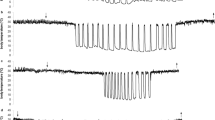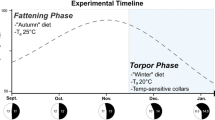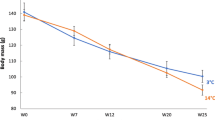Abstract
We investigated how dietary fats and oils of different fatty acid composition influence the seasonal change of body mass, fur colour, testes size and torpor in Djungarian hamsters, Phodopus sungorus, maintained from autumn to winter under different photoperiods and temperature regimes. Dietary fatty acids influenced the occurrence of spontaneous torpor (food and water ad libitum) in P. sungorus maintained at 18°C under natural and artificial short photoperiods. Torpor was most pronounced in individuals on a diet containing 10% safflower oil (rich in polyunsaturated fatty acids), intermediate in individuals on a diet containing 10% olive oil (rich in monounsaturated fatty acids) and least pronounced in individuals on a diet containing 10% coconut fat (rich in saturated fatty acids). Torpor in P. sungorus on chow containing no added fat or oil was intermediate between those on coconut fat and olive oil. Dietary fatty acids had little effect on torpor in animals maintained at 23°C. Body mass, fur colour and testes size were also little affected by dietary fatty acids. The fatty acid composition of brown fat from hamsters maintained at 18°C and under natural photoperiod strongly reflected that of the dietary fatty acids. Our study suggests that the seasonal change of body mass, fur colour and testes size are not significantly affected by dietary fatty acids. However, dietary fats influence the occurrence of torpor in individuals maintained at low temperatures and that have been photoperiodically primed for the display of torpor.
Similar content being viewed by others
Abbreviations
- BAT :
-
brown adipose tissue
- bm :
-
body mass
- FA :
-
fatty acid(s)
- MR :
-
metabolic rate
- MUFA :
-
monounsaturated fatty acid(s)
- PUFA :
-
polyunsaturated fatty acid(s)
- SFA :
-
saturated fatty acid(s)
- T a :
-
air temperature
- T b :
-
body temperature
- Ts :
-
body surface temperature(s)
- TNZ :
-
thermoneutral zone
- UFA :
-
unsaturated fatty acid(s)
References
Aloia RC, Raison JK (1989) Membrane function in mammalian hibernation. Biochim Biophys Acta 988: 123–146
Bartness TJ, Milner R, Geloen A, Trayhurn P (1991) Effects of high fat diets on hibernation and adipose tissue in Turkish hamsters. J Comp Physiol B 161: 451–459
Carneheim C, Cannon B, Nedergaard J (1989) Rare fatty acids in brown fat are substrates for thermogenesis during arousal from bibernation. Am J Physiol 256: R146-R154
Coleman RA, Florant GL, Mostafa TX, Bhat BG (1993) Molecular mechanisms for selective retention of essential fatty acids during hibernation. In: Carey C et al (eds). Life in the cold: ecological, physiological and molecular mechanisms. Westview Press, Boulder, pp 519–525
Figala J, Hoffmann K, Goldau G (1973) Zur jahresperiodik beim Djungarischen Zwerghamster Phodopus sungorus Pallas. Oecologia 12: 89–118
Flint WE (1966) Die Zwerghamster der paläarktischen Fauna. Neue Brehm-Bücherei, Ziemsen Verlag, Wittenberg
Florant GL, Nuttle LC, Mullinex DE, Rintoul DA (1990) Plasma and white adipose tissue lipid composition in marmots. Am J Physiol 258: R1128-R1131
Florant GL, Hester L, Ameenuddin S, Rintoul DA (1993) The effect of a low essential fatty acid diet on hibernation in marmots. Am J Physiol 264: R747-R753
Frank CL (1992) The influence of dietary fatty acids on hibernation by golden-mantled ground squirrels (Spermophilus lateralis) Physiol Zool 65: 906–920
Frank CL (1994) Polyunsaturate content and diet selection by ground squirrels (Spermophilus lateralis). Ecology 75: 458–463
Geiser F (1990) Influence of polyunsaturated and saturated dietary lipids on adipose tissue, brain and mitochondrial membrane fatty acid composition of a mammalian hibernator. Biochim Biophys Acta 1046: 159–166
Geiser F (1991) The effect of unsaturated and saturated dietary lipids on the pattern of daily torpor and the fatty acid composition of tissues and membranes of the deer mouse Peromyscus maniculatus. J Comp Physiol B 161: 590–597
Geiser F (1993) Dietary lipids and thermal physiology. In: Carey C et al (eds). Life in the cold: ecological, physiological and molecular mechanisms. Westview Press, Boulder, pp 141–153
Geiser F, Kenagy GJ (1987) Polyunsaturated lipid diet lengthens torpor and reduces body temperature in a hibernator. Am J Physiol 252: R897-R901
Geiser F, McAllan BM, Kenagy GJ (1994) The degree of dietary fatty acid unsaturation affects torpor patterns and lipid composition of a hibernator. J Comp Physiol B 164: 299–305
Goldman BD, Darrow JM, Duncan MJ, Yogev L (1986) Photoperiod, reproductive hormones, and winter torpor in three hamster species. In: Heller HC et al (eds) Living in the cold. Elsevier, New York, pp 341–350
Heldmaier G, Steinlechner S (1981a) Seasonal pattern and energetics of short daily torpor in the Djungarian hamster, Phodopus sungorus. Oecologia 48: 265–270
Heldmaier G, Steinlechner S (1981b) Seasonal control of energy requirements for thermoregulation in the Djungarian hamster (Phodopus sungorus), living in natural photoperiod. J Comp Physiol 142: 429–437
Hitchcock C, Nichols BW (1971) Plant lipid biochemistry. Academic Press, London New York
Hoffmann K (1972) The influence of melatonin on testes size, body weight, and pelage colour in the Djungarian hamster (Phodopus sungorus). J Comp Physiol 95: 267–282
Howard WE (1961) Seeds stored by prairie deer mice. J Mammal 42: 260–263
Loh HH, Law PY (1980) The role of membrane lipids in receptor mechanisms. Annu Rev Pharmacol Toxicol 20: 201–234
McMurchie FJ (1988) Dietary lipids and the regulation of membrane fluidity and function. In: Aloia RC et al (eds) Physiological regulation of membrane fluidity. Liss, New York, pp 189–237
Ruf T, Klingenspor M, Preis H, Heldmaier G (1991) Daily torpor in the Djungarian hamster (Phodopus sungorus): interactions with food intake, activity, and social behaviour. J Comp Physiol B 160: 609–615
Ruf T, Stieglitz A, Steinlechner S, Blank JL, Heldmaier G (1993) Cold exposure and food restriction facilitate physiological responses to short photoperiod in Djungarian hamsters (Phodopus sungorus). J Exp Zool 267: 104–112
Smith AP, Broome LS (1992) The effects of season, sex and habitat on the diet of mountain pygmy-possums (Burramys parvus). Wildl Res 19: 755–768
Sokal RR, Rohlf FJ (1981) Biometry. Freeman, New York
Steinlechner S, Heldmaier G, Weber C, Ruf T (1986) Role of photoperiod: pineal gland interaction in torpor control. In: Heller HC et al (eds) Living in the cold. Elsevier, New York, pp 301–307
Tevis L (1953) Stomach contents of chipmunks and mantled squirrels in northeastern California. J Mammal 34: 316–334
Wood WD (1993) The effect of profitability on caching by the eastern chipmunk (Tamias striatus) Am Midl Nat 129: 139–144
Zucker I (1988) Seasonal affective disorders: animal models non fingo. J Biol Rhythms 3: 209–223
Author information
Authors and Affiliations
Additional information
Communicated by H. Langer
Rights and permissions
About this article
Cite this article
Geiser, F., Heldmaier, G. The impact of dietary fats, photoperiod, temperature and season on morphological variables, torpor patterns, and brown adipose tissue fatty acid composition of hamsters, Phodopus sungorus . J Comp Physiol B 165, 406–415 (1995). https://doi.org/10.1007/BF00387311
Accepted:
Issue Date:
DOI: https://doi.org/10.1007/BF00387311




